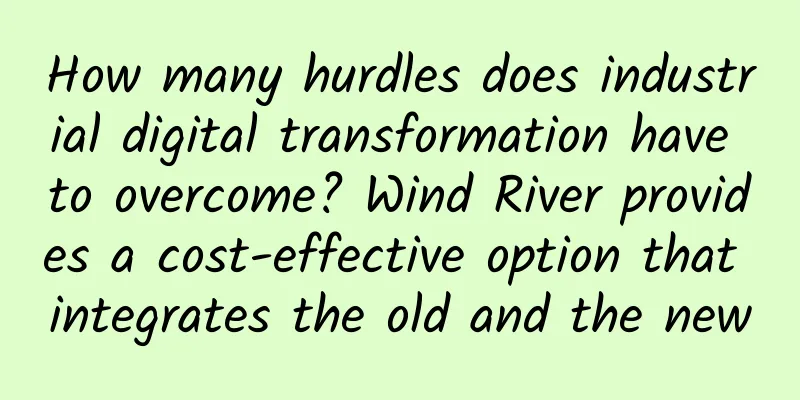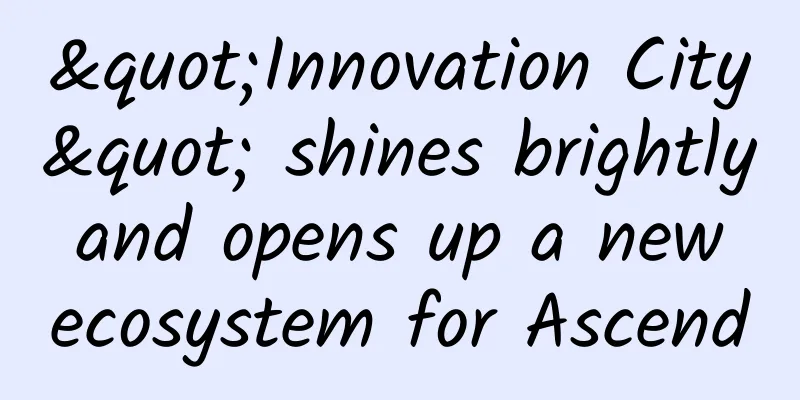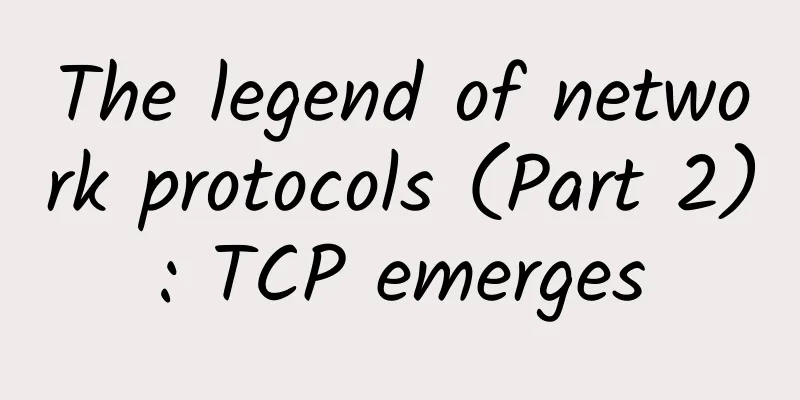How many hurdles does industrial digital transformation have to overcome? Wind River provides a cost-effective option that integrates the old and the new

|
[51CTO.com original article] "It's time to change." This is a word that Ricky Watts, vice president of industrial solutions at Wind River, frequently said at the beginning of an interview with the media. Ricky explained that from a technical perspective, most of the technologies used by the global industrial industry are 25 years old. These technologies come from a single supplier and are basically closed-structure solutions, which are obviously contrary to today's supply chain and ecosystem based on open standards; from the user's perspective, the talents who can use these technologies have gradually been replaced, and young people prefer emerging technology platforms such as cloud computing, edge computing, and high-performance computing. Therefore, the industrial industry needs to "change with the times" to better adapt to this era.
Five major challenges in the era of industrial networking Industrial transformation is necessary, but it obviously cannot be achieved overnight. Ricky is well aware of the current development status of the industrial field and pointed out that the industrial market will face five major challenges. The first three challenges are the legacy of old systems, the transformation from rigid IT to flexible IT, and meeting security and compliance requirements. In fact, these three challenges can be summarized into one point - the consideration of transformation cost and cost performance. Ricky admitted that industrial customers attach great importance to cost expenditure and always want to retain traditional systems as much as possible to reduce expenditure. For this reason, Wind River's approach is to ensure that the cost of transformation is controllable, break the previous rigid and opaque architecture, and turn it into a more open and interconnected architecture to improve cost performance and future expansion space. On the other hand, Wind River insists on not sacrificing security and non-compliance. The fourth challenge comes from network security. As we all know, the trend of interconnection and interoperability is becoming more and more obvious. Industrial systems must not only ensure the security between each other's systems, but also have certain defense capabilities to ensure that they are not attacked. The fifth challenge is to develop more functions to achieve innovation, including data analysis, increasing artificial intelligence functions, as well as data integration and more autonomous control systems. "Wind River's mission is to provide software and software-related products to help customers solve these challenges. This will provide them with a very secure and reliable foundation for digital transformation, and enable them to achieve a safer and more flexible transformation through Wind River's software. Wind River works closely with industrial customers to ensure that Wind River's products and systems fully meet the industry's high-level compliance and safety requirements." Ricky said that Wind River has always focused on providing products and services for critical infrastructure, such as autonomous driving, aerospace, industrial manufacturing and other fields. "It is no exaggeration to say that every aircraft flying in the sky has a Wind River system in its operating system to a greater or lesser extent." Helix Platform enables seamless integration of new and legacy industrial systems So how does Wind River help customers meet these challenges? This has to mention the new product Helix Virtualization Platform (Helix Platform) that Wind River just released not long ago. This product integrates Wind River's industry-leading commercial real-time operating system (RTOS) and embedded Linux into the edge computing software platform, and supports other operating systems to run in the same framework without modification, thus providing a software development environment that spans the entire Wind River product set. Simply put, it supports customers to continue using some old equipment systems, and also supports customers to transfer some functions to the new architecture. Ricky gave an example. A medical company that provides imaging equipment to dentists sells motherboards with an architecture from 20 years ago, which can no longer be used. However, if they want to switch to a new architecture, the original functions are different and the needs for migration are also different. It is understood that this motherboard has three main functions. The first is the shooting function, which uses X-rays to shoot the dental nerves and find the position that needs to be filled. This function has a safety function module. Because X-rays are harmful to the human body, once the X-rays exceed the normal standard, this function will alarm; the second function is the operating system, which allows dentists to operate and use; the third function is the imaging function, which is responsible for generating dental images for dentists to see. The medical company told Ricky that they planned to upgrade to a single, multi-core motherboard. On this new motherboard, the shooting function with the security module needs to be retained and the previous software needs to be used, while the other two functions will be merged together and use the new architecture. When they learned that Wind River had the Helix Platform, they were very excited, which meant that their idea could finally be realized. "This is the most typical example that highlights the value of Wind River Helix Platform." Ricky said that strictly speaking, the new motherboard of this medical company is actually an architecture that combines new and old functions. It must not only meet its original needs, but also ensure that the new functions added do not conflict with the previous functions. For example, adding an artificial intelligence analysis function can also be integrated with other functions. "Helix Platform means that existing mature software can run with new applications without change, thus providing comprehensive benefits." Wind River helps industry users build an autonomous world After learning about the Helix Platform, the reporter had a doubt, that is, are industrial equipment service providers motivated to promote the Wind River Helix Platform? After all, selling a brand new set of equipment has higher profits, so why bother promoting a platform that integrates the old and new? Ricky said there is no need to worry about this, for two reasons. First, the orders of industrial equipment service providers are often in the millions, and converting to a new architecture means challenging the original business model. Therefore, they are unwilling to be too radical and hope to move forward with "stability"; second, industrial equipment service providers will actually make adjustments based on the new needs of users, but what matters in the middle is the time node, which not only protects the users' investment cost-effectiveness, but also meets the needs of the new era. The market competition is so fierce that if they stand still, they will easily be replaced by new companies. Today, Helix Platform can be used in various environments, such as railway transportation, energy, and industrial environments. It can well connect existing equipment and then switch the system to new equipment without being too sudden. Customers will find the entire migration very smooth and convenient. It is worth mentioning that customers do not have to worry about its real-time operability, information security, and functional safety. All of this is solved by Wind River. Ricky also told reporters that although Helix Platform is a general-purpose platform, it also retains some customized functions to meet the characteristics of different industries. Some are to meet certification requirements, some are special functional differences in some industries, and some are to satisfy customers to use their own technology for supplementation and support. "Since its development, Wind River's products have been continuously iterated, and the platform functions are very rich, with fewer and fewer differences, which can meet the needs of most users." At the end of the interview, when talking about future development trends, Ricky believes that the future will be a more autonomous world. With the support of the operating system, people have sufficient control capabilities, analytical capabilities, and artificial intelligence technology, relying on better technical capabilities, more connected devices, and higher-performance computing capabilities, and then fully integrating with the devices to build an autonomous world. Driven by such a wave, Wind River's value is "In a more deeply interconnected world, whether it is railway transportation, the medical industry, the energy field or the public field, customers can have guaranteed system performance and security in the process of digital transformation." Ricky concluded. [51CTO original article, please indicate the original author and source as 51CTO.com when reprinting on partner sites] |
<<: How to decide if Wi-Fi 6 is right for you?
>>: Insufficient CMDB Momentum = “Failed” IT Operations?
Recommend
Perhaps it is easier to understand HTTPS this way
We won’t talk about HTTP and HTTPS first. Let’s s...
CAICT's first batch of AIOps systems and tools evaluations, Borui Data was rated "comprehensive" for anomaly detection module
Recently, Swift-AI, the intelligent operation and...
80VPS: US 8C cluster server monthly payment starts from 800 yuan, Hong Kong 8C cluster server monthly payment starts from 1000 yuan
Recently, some readers asked about cluster server...
Lenovo Debuts at Microsoft IoT Conference, Driving Business Intelligence Innovation with Smart IoT Devices
On December 3, the highly anticipated 2019 Micros...
BuyVM Las Vegas VPS simple test
BuyVM has been shared many times in the blog. It ...
Transitioning from IPv4 to IPv6, you can't miss these knowledge points
[[277315]] Understanding the network model The ne...
CheapWindowsVPS: $4.5/month KVM-4GB/60GB/1Gbps unlimited traffic/7 data centers available
The last time I shared information about CheapWin...
Cisco Launches AppDynamics Cloud to Build Superior Digital Experiences
summary Cisco launches AppDynamics Cloud, a cloud...
HostKvm: Russia CN2 bandwidth upgrade, Russia/Hong Kong high-defense limited 50% discount is in progress
HostKvm is a foreign VPS service provider founded...
It's no big deal for the three major operators to withdraw from the US
After several twists and turns, China's three...
After FTTH: Who will lead the development of the optical fiber and cable industry?
[[184117]] Fiber optic cables are currently widel...
Changes to the Internet in 2018
There are already many articles in the industry p...
The road to containerized network functions
【51CTO.com Quick Translation】Service providers an...
In the 5G era, how do the three major operators fight the edge war?
5G makes the Internet of Everything possible. Whi...









